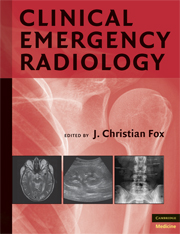Book contents
- Frontmatter
- Contents
- Contributors
- PART I PLAIN RADIOGRAPHY
- PART II ULTRASOUND
- 12 Introduction to Bedside Ultrasound
- 13 Physics of Ultrasound
- 14 Biliary Ultrasound
- 15 Trauma Ultrasound
- 16 Deep Venous Thrombosis
- 17 Cardiac Ultrasound
- 18 Emergency Ultrasonography of the Kidneys and Urinary Tract
- 19 Ultrasonography of the Abdominal Aorta
- 20 Ultrasound-Guided Procedures
- 21 Abdominal—Pelvic Ultrasound
- 22 Ocular Ultrasound
- 23 Testicular Ultrasound
- 24 Abdominal Ultrasound
- 25 Emergency Musculoskeletal Ultrasound
- 26 Soft Tissue Ultrasound
- 27 Ultrasound in Resuscitation
- PART III COMPUTED TOMOGRAPHY
- PART IV MAGNETIC RESONANCE IMAGING
- Index
- Plate Section
16 - Deep Venous Thrombosis
from PART II - ULTRASOUND
Published online by Cambridge University Press: 07 December 2009
- Frontmatter
- Contents
- Contributors
- PART I PLAIN RADIOGRAPHY
- PART II ULTRASOUND
- 12 Introduction to Bedside Ultrasound
- 13 Physics of Ultrasound
- 14 Biliary Ultrasound
- 15 Trauma Ultrasound
- 16 Deep Venous Thrombosis
- 17 Cardiac Ultrasound
- 18 Emergency Ultrasonography of the Kidneys and Urinary Tract
- 19 Ultrasonography of the Abdominal Aorta
- 20 Ultrasound-Guided Procedures
- 21 Abdominal—Pelvic Ultrasound
- 22 Ocular Ultrasound
- 23 Testicular Ultrasound
- 24 Abdominal Ultrasound
- 25 Emergency Musculoskeletal Ultrasound
- 26 Soft Tissue Ultrasound
- 27 Ultrasound in Resuscitation
- PART III COMPUTED TOMOGRAPHY
- PART IV MAGNETIC RESONANCE IMAGING
- Index
- Plate Section
Summary
Deep venous thrombosis (DVT) is an extremely common disorder, estimated to occur in approximately 2 million Americans per year (1). The most serious complication of a DVT is a pulmonary embolism, thereby emphasizing the importance of timely diagnosis and initiation of treatment. There are numerous methods to diagnose a DVT, but ultrasonography has become the imaging modality of choice. A complete lower extremity vascular study images the veins of the leg from the groin to the ankle. Bedside ultrasonography does not usually involve a complete vascular exam, in that only the proximal vessels, the femoral and the popliteal veins are imaged, without imaging the calf veins. Although a DVT may originate in the distal part of the leg, a calf DVT is not believed to be as clinically relevant as a proximal clot. Most calf vein DVTs spontaneously resolve, and even if they do embolize, they tend to be small and do not usually cause major complications (1). However, some experts disagree whether an isolated calf DVT requires anticoagulation (2). Studies have shown that emergency physicians can accurately and efficiently employ bedside ultrasonography in the diagnosis of an acute DVT (3,4).
INDICATIONS
Ultrasonography of an extremity to check for the presence of a DVT is a commonly requested examination.
Keywords
- Type
- Chapter
- Information
- Clinical Emergency Radiology , pp. 246 - 253Publisher: Cambridge University PressPrint publication year: 2008

